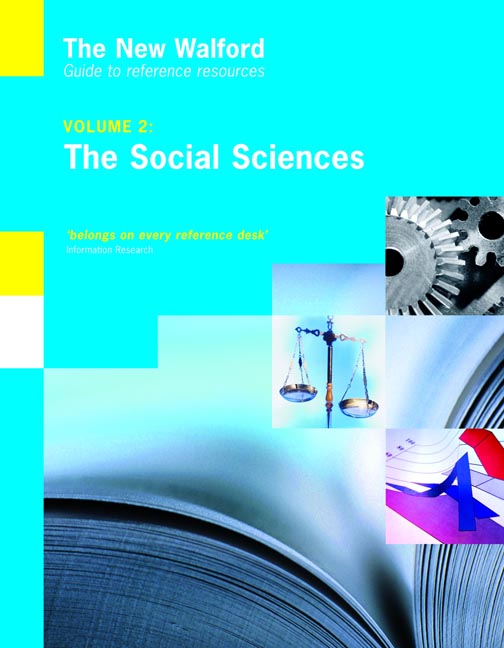Book contents
- Frontmatter
- Contents
- Preface
- Quick-start guide
- Editorial Board and Subject Specialists
- Introduction
- SOCIAL SCIENCES: GENERIC RESOURCES
- PSYCHOLOGY, SOCIOLOGY & SOCIAL WORK
- POLITICS, GOVERNMENT & LAW
- FINANCE, INDUSTRY & BUSINESS
- EDUCATION & SPORT
- MEDIA & INFORMATION
- TOOLS FOR INFORMATION PROFESSIONALS
- INDEXES
Introduction
Published online by Cambridge University Press: 09 June 2018
- Frontmatter
- Contents
- Preface
- Quick-start guide
- Editorial Board and Subject Specialists
- Introduction
- SOCIAL SCIENCES: GENERIC RESOURCES
- PSYCHOLOGY, SOCIOLOGY & SOCIAL WORK
- POLITICS, GOVERNMENT & LAW
- FINANCE, INDUSTRY & BUSINESS
- EDUCATION & SPORT
- MEDIA & INFORMATION
- TOOLS FOR INFORMATION PROFESSIONALS
- INDEXES
Summary
This Introduction covers:
■ Introducing TNW
■ What's new about TNW?
■ The new information universe
■ Selection and description of resources
■ Organization and arrangement of entries
Introducing TNW
The second volume of The New Walford (TNW) is a guide to reference resources in the Social Sciences. It provides a collection of resources aimed particularly at helping people to research unfamiliar subject areas. It offers comprehensive coverage of the range of resources available in the networked world, but is necessarily selective in the set of items chosen for each subject field. Our aim is to get you started, to help you navigate uncharted territory and find the right types of resources to meet your needs.
This new guide builds on the reputation and concept of the classic Walford's guide to reference material, but we have made radical changes to the design, focus and layout. The internet and the world wide web have had a dramatic impact on the quantity and quality of information resources. The new information universe is diverse and complex with its mix of established and emergent media.
What's new about TNW?
TNW has been completely ‘re-engineered’ for the hybrid information world. There are seven key changes from ‘The Old Walford’.
■ Focus on the newcomer – TNW has been specially designed to help the less-experienced user of Social Science resources, particularly people researching a field for the first time.
■ Simpler subject arrangement – TNW has moved away from the Universal Decimal Classification (UDC) and adopted its own straightforward threelevel scheme of subject parts, subject groupings and subject fields.
■ Navigation by topic – TNW's new TOPIC INDEX helps you to find your way quickly from a subject heading or an alternative sought term to the right place in the main sequence.
■ New resource categorization – TNW has replaced the 40 or so ‘form headings’ used in the old Walford with a new simpler set of 13 resource categories.
■ Expansion of resource types – TNW includes the full spectrum of resources now available to the internet user, with thousands of organizational websites and portals complementing its coverage of traditional reference tools.
■ Introductory essays – TNW also helps the Social Sciences newcomer by offering short narrative introductions, highlighting key features of each major subject area.
- Type
- Chapter
- Information
- The New Walford Guide to Reference ResourcesSocial Sciences, pp. xii - xviPublisher: FacetPrint publication year: 2007



